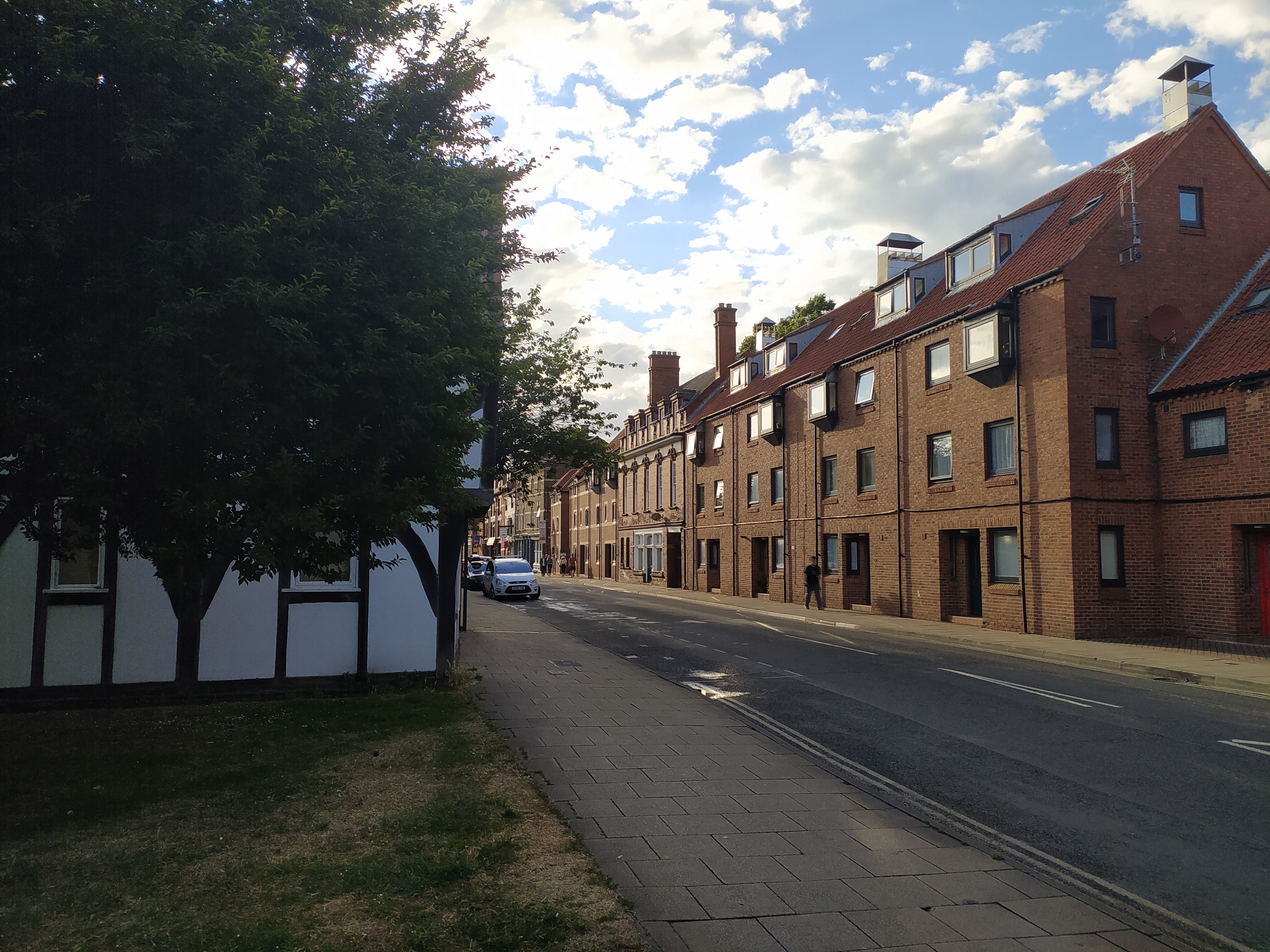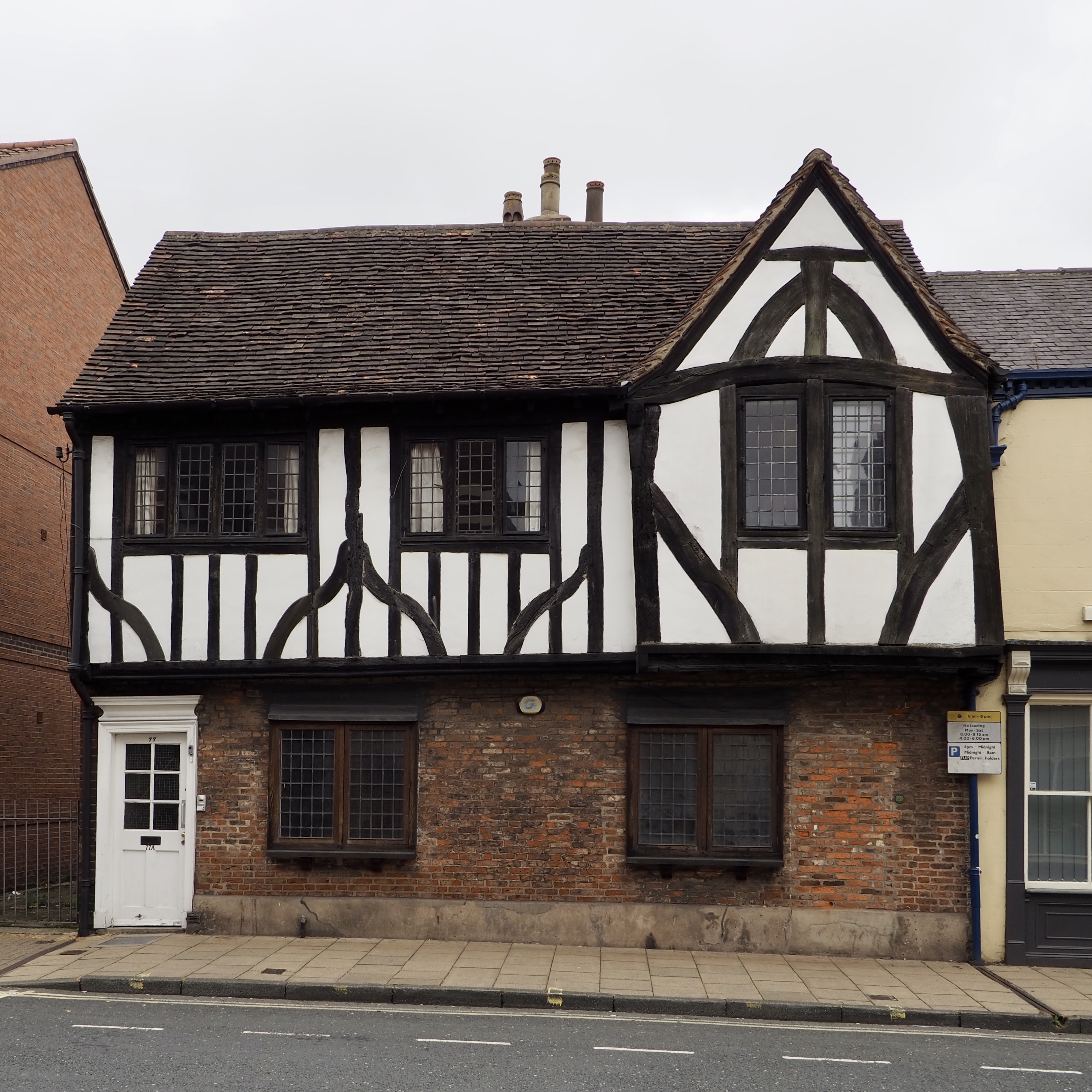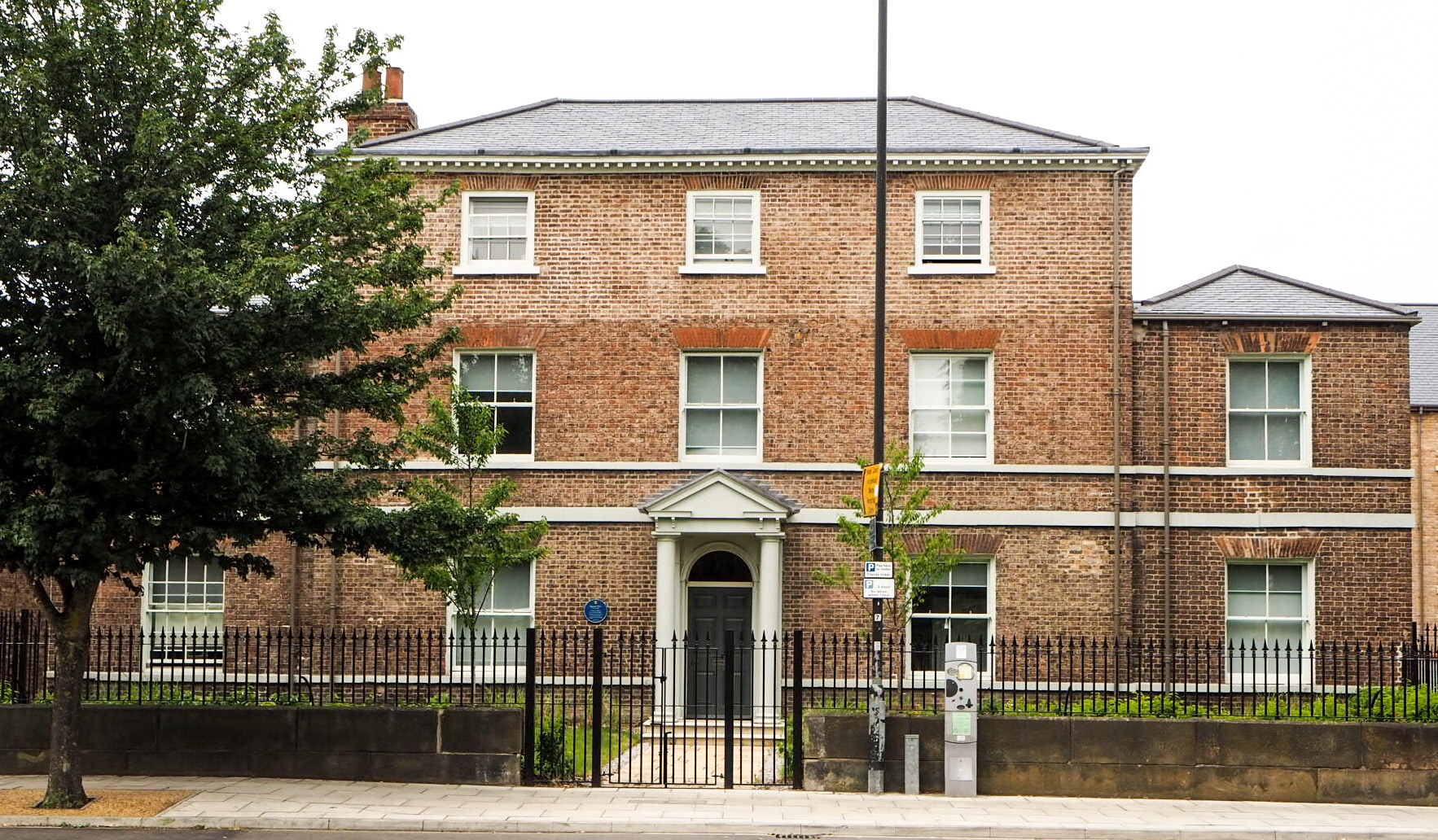|
Walmgate
Walmgate is a street in the city centre of York, in England. During the Middle Ages, Medieval period, the street was the site of a seafissh and cattle market. Walmgate Bar, was involved in the Siege of York in 1644, during the First English Civil War. During the 20th century, many of the older buildings were cleared away and newer structures put up. History The street lay outside Roman Eboracum, and although it was crossed by a Roman road, evidence of occupation in the period is limited to two wharfs on the River Foss, and some burials. The road appears to have developed in the Viking Jorvik period, during which it mostly hosted industrial and commercial uses. The street was first mentioned in about 1080, as "Walbegate", suggesting it may be named after an individual called "Walba". Walmgate Bar, the gate at the south-east end of the street, was built before 1155, but the section of the York city walls enclosing the street was built later: permission to construct this sectio ... [...More Info...] [...Related Items...] OR: [Wikipedia] [Google] [Baidu] |
Walmgate
Walmgate is a street in the city centre of York, in England. During the Middle Ages, Medieval period, the street was the site of a seafissh and cattle market. Walmgate Bar, was involved in the Siege of York in 1644, during the First English Civil War. During the 20th century, many of the older buildings were cleared away and newer structures put up. History The street lay outside Roman Eboracum, and although it was crossed by a Roman road, evidence of occupation in the period is limited to two wharfs on the River Foss, and some burials. The road appears to have developed in the Viking Jorvik period, during which it mostly hosted industrial and commercial uses. The street was first mentioned in about 1080, as "Walbegate", suggesting it may be named after an individual called "Walba". Walmgate Bar, the gate at the south-east end of the street, was built before 1155, but the section of the York city walls enclosing the street was built later: permission to construct this sectio ... [...More Info...] [...Related Items...] OR: [Wikipedia] [Google] [Baidu] |
Walmgate Bar
York has, since Roman times, been defended by walls of one form or another. To this day, substantial portions of the walls remain, and York has more miles of intact wall than any other city in England. They are known variously as York City Walls, the Bar Walls and the Roman walls (though this last is a misnomer as very little of the extant stonework is of Roman origin, and the course of the wall has been substantially altered since Roman times). The walls are generally 13 feet (4m) high and 6 feet (1.8m) wide. History Roman walls The original walls were built around 71 AD, when the Romans erected a fort (castra) occupying about 50 acres or 21.5 hectares near the banks of the River Ouse. The rectangle of walls was built as part of the fort's defences. The foundations and the line of about half of these Roman walls form part of the existing walls, as follows: *a section (the west corner, including the Multangular Tower) in the Museum Gardens *the north-west and north-ea ... [...More Info...] [...Related Items...] OR: [Wikipedia] [Google] [Baidu] |
York City Walls
York has, since Roman times, been defended by walls of one form or another. To this day, substantial portions of the walls remain, and York has more miles of intact wall than any other city in England. They are known variously as York City Walls, the Bar Walls and the Roman walls (though this last is a misnomer as very little of the extant stonework is of Roman origin, and the course of the wall has been substantially altered since Roman times). The walls are generally 13 feet (4m) high and 6 feet (1.8m) wide. History Roman walls The original walls were built around 71 AD, when the Romans erected a fort (castra) occupying about 50 acres or 21.5 hectares near the banks of the River Ouse. The rectangle of walls was built as part of the fort's defences. The foundations and the line of about half of these Roman walls form part of the existing walls, as follows: *a section (the west corner, including the Multangular Tower) in the Museum Gardens *the north-west and north-ea ... [...More Info...] [...Related Items...] OR: [Wikipedia] [Google] [Baidu] |
77 Walmgate
77 Walmgate is a timber framed building in the city centre of York, in England. The oldest part of the building is the 15th century cross wing, the west part of the current building, with its gable end to Walmgate. A hall range was added in the 16th century, and this is the eastern part of the current building. Its timber frame is exposed, and its ogee braces are typical of the period. At some point, the ground floor was rebuilt in brick, but the upper floor is still jettied over it. A wing was added at the rear in the early 18th century, and the building was altered in the 19th and 20th centuries. Inside, many historic features survive, including wooden panelling, a reset staircase, and a fireplace on the first floor. The building was grade II* listed in 1954. In 1957, it was purchased by the York Conservation Trust, who let it as a shop with a flat above. References [...More Info...] [...Related Items...] OR: [Wikipedia] [Google] [Baidu] |
Lawrence Street (York)
Lawrence Street is a road in York, in England, immediately south-east of the city centre. History A Bronze Age cremation urn has been found in excavations by Lawrence Street, the only prehistoric remains found in central York. The street was originally constructed as a Roman road, but there is no evidence of Roman occupation in the area, only pottery shards and possible signs of a clay quarry, the area otherwise being used as farmland. There was some Anglo-Saxon building along the street, extending out from Walmgate. The Normans built an earthwork across the line of the street, and in the 12th century Walmgate Bar was constructed in it. In the 14th-century, the York city walls were extended over the earthwork, with Lawrence Street remaining entirely outside. St Edward the Martyr Church was built immediately outside Walmgate Bar, and St Lawrence's Church also existed by the 12th century. In 1142, St Nicholas's Hospital was built on the street, with its chapel used as a furt ... [...More Info...] [...Related Items...] OR: [Wikipedia] [Google] [Baidu] |
York
York is a cathedral city with Roman origins, sited at the confluence of the rivers Ouse and Foss in North Yorkshire, England. It is the historic county town of Yorkshire. The city has many historic buildings and other structures, such as a minster, castle, and city walls. It is the largest settlement and the administrative centre of the wider City of York district. The city was founded under the name of Eboracum in 71 AD. It then became the capital of the Roman province of Britannia Inferior, and later of the kingdoms of Deira, Northumbria, and Scandinavian York. In the Middle Ages, it became the northern England ecclesiastical province's centre, and grew as a wool-trading centre. In the 19th century, it became a major railway network hub and confectionery manufacturing centre. During the Second World War, part of the Baedeker Blitz bombed the city; it was less affected by the war than other northern cities, with several historic buildings being gutted and restore ... [...More Info...] [...Related Items...] OR: [Wikipedia] [Google] [Baidu] |
St Denys's Church, York
St Denys' Church, York is a Grade I listed parish church in the Church of England on Walmgate in York. History It was built on the site of a Saxon church and possibly of a Roman temple (the earliest records date from ). Inside some of the earliest stained glass in York can be found: the sculpted Norman doorway and 15th century heraldic roof are also noteworthy features. The figure of St Denys can be seen in the 15th-century east window – fewer than 40 English churches are dedicated to this French saint. The church was originally a lot larger than it is now, as part of the church subsided after the king's fishpool was drained; another part gave way shortly after as a sewer was being built nearby and the current main entrance is situated where a window used to be. Originally it also had a spire but, unfortunately, between the 17th and 18th century it was hit by a cannon shot and struck by lightning. The spire was only removed 20 years later after being partially blown down. ... [...More Info...] [...Related Items...] OR: [Wikipedia] [Google] [Baidu] |
St Margaret, Walmgate
St Margaret's Church, on Walmgate, in York, is a Grade I listed former parish church in the Church of England in York. History The church dates from the 12th century of which the south porch is the only surviving element. The nave is 14th century and the vestry 15th. The tower was rebuilt between 1684 and 1685. The church was restored by Thomas Pickersgill between 1851 and 1852. The north wall was moved out by 2 yards, the gallery was extended and the church had a new floor laid and was re-pewed. A new roof was added to the nave. In 1974 the church was declared redundant by the Church of England. The York Theatre Royal used it for storage. In 2000 it reopened as a venue for the National Centre for Early Music, and is now used for performances and as a venue. Organ The pipe organ dated from 1855 and was by Ward. A specification of the organ can be found on the National Pipe Organ Register. The organ is no longer present inside the church. References {{DEFAULTSORT:York, ... [...More Info...] [...Related Items...] OR: [Wikipedia] [Google] [Baidu] |
Fossgate
Fossgate is a street in the city centre of York, in England. History The street is believed to follow the line of a Roman road leading south-east out of Eboracum. Although it lay outside the Roman walls, it is known that there was a civilian settlement in the area. There is no evidence of occupation in the Anglian period, but in Scandinavian Jorvik, it was fully built up, mostly for industrial and commercial uses. The street was first mentioned in about 1130. In the Medieval period, it fell within the parish of St Crux, and that church was sometimes regarded as lying on the street, although it was entered from Pavement. In 1295, the York Carmelite Friary was built to the east of the street, and it was entered from a gateway near the Pavement end of Fossgate. In 1357, the Merchant Adventurer's Hall was built, set back from the street. Many of the boundaries between building plots also date from this period. In 1590, a cattle market was established on the street, held ... [...More Info...] [...Related Items...] OR: [Wikipedia] [Google] [Baidu] |
The Red Lion, York
The Red Lion is a pub in the city centre of York, in England. The building originated as a house, in a yard off Walmgate. The original part of the building is to the north-east, built in the 15th century as a house with a first floor hall and other rooms below. It appears to have been truncated at the north-west end, and is now one-and-a-half bays long. The south-eastern end of the building was rebuilt around 1600, and an attic was also inserted. In the 17th century, a lower wing was added to the south-west, in two stages, with a ground floor of brick. There were further extensions in the 18th century, and a new front was added in the 19th century. The building is timber framed, but has been largely reconstructed over the years. The windows are 20th-century. On the first floor, there is an access between two bedrooms, linked to the chimney, which has been described as a priest hole. In the front bar is a bread oven, which the pub claims dates from the 13th century, and o ... [...More Info...] [...Related Items...] OR: [Wikipedia] [Google] [Baidu] |
Bowes Morrell House
The Bowes Morrell House is a historic building on Walmgate in the city centre of York, in England. The house was one of four for which a licence was granted in 1396 to construct in the churchyard of St Peter-le-Willows. It may have been used as a vicarage for the church, or alternatively for St Margaret's Church. In later years, the building was a cheap lodging house for travelling workers. By the late 19th-century, it was owned by the O'Hara family, bought out by the Kilmartin family in the 1930s. It was nicknamed the "doss house", and had a sign above the door reading "good lodgings down this passage", despite its reputation for poor-quality accommodation. The house is timber framed, with two stories, and originally had an L plan, with the main section being a hall 20 feet long and 10-and-a-half feet wide. An extension was built in the 16th century, giving the building a square plan. In the late-17th century, a further extension was added in brick to the south end of the ... [...More Info...] [...Related Items...] OR: [Wikipedia] [Google] [Baidu] |
National Centre For Early Music
The National Centre for Early Music (NCEM) is organisation encourages, promotes and disseminates early music. Located in York, England, it is based in the converted and extended, Grade I listed medieval church of St Margaret, Walmgate. Each year, the NCEM organises the York Early Music Festival. Overview Designed by van Heyningen and Haward Architects, the centre was opened in April 2000. It was created, with the aid of a grant from the National Lottery and partnership money from organisations such as English Heritage. The buildings of the Centre include a performance space (in the former church) and facilities for conferences and other events and recordings. Historic keyboard instruments are available for hire. The church building, which had been redundant for some years, was upgraded to meet the needs of varying types and size of performance as well as many alternative uses such as teaching, conferences and exhibitions. [...More Info...] [...Related Items...] OR: [Wikipedia] [Google] [Baidu] |









